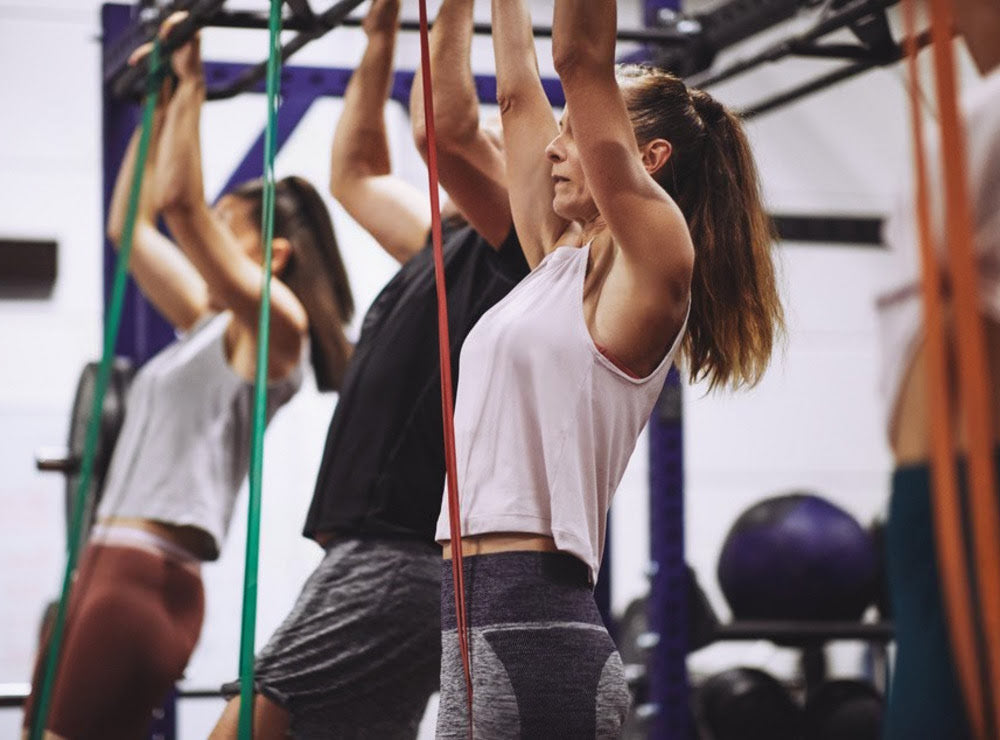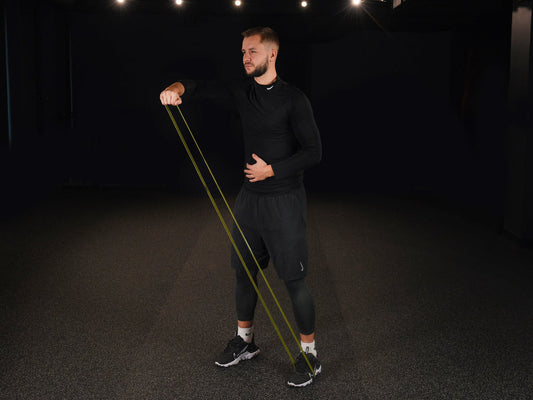Pull-ups with assistance bands are one of the most effective upper body exercises, yet many fitness enthusiasts find them challenging. Assistance bands offer a solution that makes this powerful exercise accessible to everyone, regardless of their current strength level. Resistance bands can transform your pull-up journey by helping you build strength progressively while maintaining proper form.
- 1. Understanding Pull-Ups and Their Benefits
- 2. The Role of Assistance Bands in Pull-Up Training
- 3. How to Choose the Right Assistance Band for Your Fitness Level
- 4. Proper Technique for Performing Pull-Ups with Assistance Bands
- 5. Progressing from Assisted Pull-Ups to Unassisted Pull-Ups
- 6. Common Mistakes to Avoid When Using Assistance Bands
- 7. Incorporating Pull-Ups with Assistance Bands into Your Workout Routine
- 8. Alternative Exercises to Complement Your Pull-Up Training
- 9. Summary
Understanding Pull-Ups and Their Benefits
Pull-ups with assistance bands are a compound exercise that engages multiple muscle groups at once. When performed correctly, pull-ups primarily target the latissimus dorsi (lats), the large muscles spanning the middle and lower back. They also activate the biceps, shoulders, rhomboids, and core muscles.
Regular pull-up training yields impressive physical benefits. Studies show that consistent pull-up practice leads to increased upper body strength, improved posture, and enhanced grip strength. The functional strength developed through pull-ups translates to everyday activities that require pulling motions, such as opening heavy doors or lifting objects.
Beyond the physical advantages, mastering pull-ups provides psychological benefits. The progression from assisted to unassisted pull-ups creates measurable milestones that boost confidence and motivation. Many fitness enthusiasts consider the first unassisted pull-up a significant achievement in their strength training journey.
The Role of Assistance Bands in Pull-Up Training
Assistance bands are large, looped elastic bands designed to counteract a portion of your body weight, making pull-ups more manageable. These bands attach to the pull-up bar and provide upward assistance through their elastic resistance. The amount of assistance depends on the band’s thickness — thicker bands provide more assistance, while thinner bands offer less.
The science behind band-assisted pull-ups shows their effectiveness. Research indicates that assistance bands maintain the natural movement pattern of pull-ups while reducing the load. This allows practitioners to perform higher repetitions with proper form, leading to better muscle development and neural adaptation.
Assistance bands offer several advantages over other pull-up assistance methods. Unlike machine-assisted alternatives, bands provide variable resistance throughout the movement — offering more assistance at the bottom of the pull-up (the most challenging position) and gradually decreasing assistance as you rise. This variable resistance pattern matches the natural strength curve of the exercise.
How to Choose the Right Assistance Band for Your Fitness Level
Selecting the appropriate resistance band requires an understanding of the different resistance levels available. Bands typically come in color-coded options representing various levels of assistance. For example, black bands usually provide minimal assistance (about 15-35 pounds), while green or blue bands might offer moderate assistance (35-65 pounds), and red or purple bands deliver maximum assistance (65-175 pounds).
To determine your ideal starting point, consider your current strength level and pull-up abilities. If you cannot perform any unassisted pull-ups, start with a heavier band that allows you to complete 8-10 repetitions with proper form. If you can perform 1-3 unassisted pull-ups, a medium resistance band might be appropriate for building endurance.
Many fitness experts recommend purchasing a set of bands with varying resistance levels for pull-ups with assistance bands. This approach allows for progressive training as your strength increases. Starting with heavier assistance and gradually transitioning to lighter bands provides clear progression markers on your journey to unassisted pull-ups.
Proper Technique for Performing Pull-Ups with Assistance Bands
Setting up your assistance band correctly ensures both safety and effectiveness. Begin by looping the band around the pull-up bar, creating a secure attachment point. Place one knee or foot into the bottom loop of the band, allowing it to support some of your body weight. Ensure the pull-up assistance bands remain centered to prevent any sideways pull during the exercise.
Correct pull-up form is crucial, even with assistance. Grip the bar slightly wider than shoulder-width apart with your palms facing away from you (for standard pull-ups). Hang with your arms fully extended, maintaining a slight retraction of your shoulder blades. Initiate the movement by pulling your elbows down and back, not by lifting your knees or kicking. Pull until your chin clears the bar, then lower yourself with control to the starting position.
Breathing technique enhances performance during assisted pull-ups. Exhale during the pulling phase (concentric movement) and inhale during the lowering phase (eccentric movement). This breathing pattern maximizes oxygen flow and helps maintain core stability throughout the exercise.
Progressing from Assisted Pull-Ups to Unassisted Pull-Ups
Effective progression requires a systematic approach. Begin with a resistance band that allows you to perform 3 sets of 8-12 repetitions with proper form. Once you can consistently complete 12 repetitions across all sets, switch to a lighter band. Continue this pattern, gradually decreasing assistance until you no longer need a band. If you're looking for more guidance on structuring your workout progress, check out weekly resistance band routines.
Creating a realistic timeline helps maintain motivation. Most individuals require 3-6 months of consistent training to progress from heavily assisted to unassisted pull-ups. This timeframe varies based on training frequency, nutritional habits, recovery practices, and genetic factors.
Tracking progress is essential for long-term success. Keep a training journal documenting the band resistance used, repetitions completed, and subjective difficulty ratings. This documentation provides concrete evidence of improvement and helps identify plateaus that require program adjustments.
Common Mistakes to Avoid When Using Assistance Bands
Several technical errors can hinder progress. Using excessive momentum by swinging or kicking reduces muscle engagement and limits strength development. Improper band setup, such as off-center placement or insecure attachment, creates uneven resistance and potential safety hazards. Incomplete range of motion, either by not fully extending at the bottom or not clearing the chin above the bar at the top, diminishes training benefits.
Program design mistakes can also impede advancement. Neglecting progressive overload by staying with the same band resistance too long prevents adaptation. Insufficient volume (total repetitions) or frequency (training sessions per week) slows strength acquisition. Conversely, excessive training without adequate recovery leads to overtraining and potential injury.
Addressing these mistakes requires mindful practice and occasionally recording your technique for review. Many experienced lifters recommend periodically filming your assisted pull-ups from different angles to identify form issues that might not be apparent during execution.
Incorporating Pull-Ups with Assistance Bands into Your Workout Routine

Structuring an effective pull-up program requires strategic planning. For beginners, performing assisted pull-ups twice weekly allows for sufficient recovery between sessions. Each session might include 3-4 sets of 8-12 repetitions. As strength increases, advanced practitioners can increase frequency to three weekly sessions, incorporating varied grip styles and resistance levels.
Sample workout plans illustrate practical implementation. A balanced upper body day might begin with 3 sets of assisted pull-ups, followed by rows, push-ups, and shoulder exercises. Alternatively, a full-body approach might include assisted pull-ups paired with squats in a superset format, maximizing workout efficiency. To enhance your training, consider adding these loop band exercises for a more comprehensive strength routine.
Recovery considerations play a crucial role in progress. Allow at least 48 hours between pull-up sessions to permit muscle repair and growth. Proper nutrition, particularly adequate protein intake (approximately 1.6-2.2g per kg of bodyweight daily), supports recovery. Quality sleep, averaging 7–9 hours nightly, enhances muscle growth and neural adaptation.
Alternative Exercises to Complement Your Pull-Up Training
Supplementary exercises accelerate pull-up development. Lat pulldowns closely mimic the pull-up movement pattern while allowing precise weight selection. Inverted rows strengthen the same muscle groups from a different angle, enhancing overall back development. Scapular pull-ups, which involve hanging from the bar and retracting the shoulder blades without bending the elbows, develop the crucial initial phase of the pull-up movement.
Grip strength exercises deserve special attention. Dead hangs, where you simply suspend from the bar for time, build grip endurance and shoulder stability. Farmer’s carries develop forearm strength that transfers directly to pull-up performance. Specific grip training tools like grippers or thick-handled implements further enhance this often-overlooked aspect of pull-up proficiency.
Core strengthening supports pull-up performance by improving body stability during the movement. Planks, hollow holds, and hanging knee raises develop the core strength necessary for maintaining proper body position throughout the pull-up motion.
Summary
Assistance bands provide an evidence-based method for developing pull-up strength progressively and safely. The versatility of assistance bands makes pull-up training accessible to virtually everyone, regardless of current fitness level. Whether you're working toward your first unassisted pull-up or aiming to increase your repetition maximum, these simple tools offer a solution tailored to your specific needs.
Start incorporating pull-ups with assistance bands into your workouts today and experience the transformation in your strength and endurance. Experiment with different bands, keep track of your progress, and celebrate your achievements along the way. Embrace the challenge and watch your fitness level soar to new heights.










